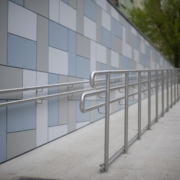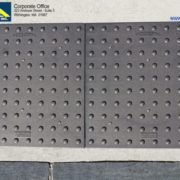Who Is Seiichi Miyake and Why Did He Make Truncated Domes?
In 1965, the inventor Seiichi Miyake created something that would spread to almost every civilized country in the world. Since the creation of truncated domes, a tactile warning surface that is built into sidewalks and pedestrian thoroughfares, they have been installed throughout his native Japan, as well as Australia, the United Kingdom, Canada, and the United States.
Seiichi Miyake wanted to help people with visual impairments travel safely through the streets of Tokyo. He was also worried that people who could not see well were in danger when boarding a train. In the 1970s, all Japan Railway platforms were modified to include tactile warning surfaces, which were in two distinct patterns.
The Start of Truncated Domes
To help a close friend who was visually impaired, Miyake spent his own money to develop what were then known as Tenji blocks, the first form of tactile surface. The first pattern was a series of lines that indicated that the person traveling along the path should continue forward. The second pattern consisted of truncated domes, which would indicate the person should stop because of a change in direction or a transition from sidewalk to motorway, or that they were reaching the end of the boarding platform and should wait for the train to stop before proceeding.
Tactile tiles were designed to be felt through a person’s shoes, a cane, or the help of guide dogs. Seiichi Miyake’s tactile blocks were first installed in a public setting in 1967. A street in Okayama City, Japan was the first location where tactile blocks were placed, near the Okayama School for the Blind. A decade later, they became a mandatory requirement for Japanese National Railways.
Since the United States enacted the ADA, truncated domes have become mandatory on all sidewalks, in all train stations, and on public thoroughfares that coincide with motorized traffic areas. While they do not require the lined tiles that mean “go” in Japan, they do require the textured tiles that mean “stop.”
Celebrating Seiichi Miyake and His Work
Seiichi Miyake passed away in 1982, but his invention has not been forgotten. In March 2019, Google revealed a doodle to celebrate the Japanese inventor, which depicted a rendering of the tactile blocks created by Miyake. Circles, representing an impending hazard or landmark (such as a bus stop), were placed on a yellow background representing the mats. The doodle also demarcates the straight line used to point an individual in the right direction.
On the doodle, the letters spelling out Google are denoted via colored circles on the mats, while an animation of a probing cane is featured.
Applications Today
Named for the Japanese system of braille, Tenji blocks have been transformed into the detectable warning surfaces used around the world today. These tactile surfaces have been adapted for a variety of locations, including:
- Sidewalk Paving: Tactile sidewalk paving is often used to provide a sense of direction in crowded areas. Ribbed pavement helps pedestrians know whether to turn left or right, for example, and provides a visual indication of a change in direction. It is usually different in color from the rest of the pavement.
- Train Stations: Blocks, similar to the original invention, are used at above- and below-ground train stations. Surfaces with raised domes, also known as offset blisters, indicate when people are too close to the platform edge when waiting for a train. They’re usually a bright yellow color to alert everyone to stay clear of danger.
- Public Transportation Zones: Raised blocks are used on sidewalks near streets where buses, rails, and trams stop. The bumps used here are often slightly larger than what Miyake designed, but this lozenge paving looks similar, although more like a cluster of cough drops, to warn people of oncoming traffic and where trams stop.
- Stairs: Rounded rods, or “corduroy paving” is positioned horizontally ahead of a drop in pavement. Used at the top and bottom of staircases, these surfaces are often a different color from surrounding concrete and let visually impaired individuals know where a staircase starts and ends, and how high it may be.
- Bicycle Lanes: In multi-use pedestrian spaces, softer ribbed blocks and bars may be used to demarcate where bikers or pedestrians should use a sidewalk. An example is a sidewalk with a central bar separating ribbed blocks in the bike lane from horizontal blocks on the pedestrian side, which would act as speed bumps if a bicyclist veered onto that side.
To find out more about this amazing invention by Seiichi Miyake and how it can help you protect persons with visual disabilities, please contact ADA Solution by calling 800-372-0519.









